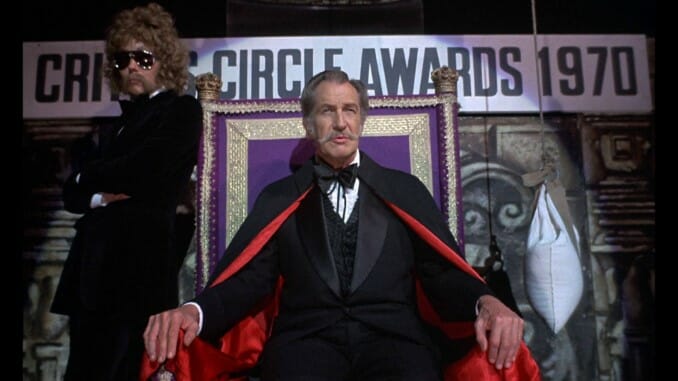
Paste’s ABCs of Horror 2 is a 26-day project that highlights some of our favorite horror films from each letter of the alphabet. The only criteria: The films chosen can’t have been used in 2019’s Century of Terror, a 100-day project to choose the best horror film of every year from 1920-2019, nor last year’s first ABCs of Horror project. With many heavy hitters out of the way, which movies will we choose?
When a film fan pictures the refined countenance of the great Vincent Price, the actor’s face is almost certainly projecting a certain sense of puckish mischief. For a man so consistently and inherently associated with the macabre or the horror genre, one might expect the thought of Price to evoke a more genuine sense of terror, or unease, but Price’s particular brand of horror almost inevitably came saddled with good-natured humor or camp appeal. Even his relatively earnest, Roger Corman-directed horror stories adapting the works of Edgar Allan Poe in the early 1960s had a certain twinkle of mischief to them that Price brought to almost all of his performances—a grand theatricality brought by Price’s ability to chew scenery and embellish what otherwise could have been dull characters.
By the mid-1960s, though? Well, that’s about the time when Vincent Price stopped trying to genuinely frighten anyone, and began to fully embrace the campy attitude that fans now intimately associate with the man. From the time of 1965’s Dr. Goldfoot and the Bikini Machine onward, Price reveled in films that saw him performing as truly ludicrous or deranged characters, ever more absurd and flamboyant in their wicked scheming. There were occasional exceptions to that rule, like Price’s genuinely despicable turn as charlatan witch hunter Matthew Hopkins in 1968’s Witchfinder General, but they were few and far between. Instead, this era of Price is best captured by the campy, grandiloquent archfiends he inhabited in 1971’s The Abominable Dr. Phibes and 1973’s Theatre of Blood, the latter of which Price would go on to describe as his favorite acting performance.
Theatre of Blood is a classic revenge story in the Grand Guignol tradition, following a single mastermind as he hunts down and messily dispatches all who have wronged him in ironic fashion. Price is playing Shakespearean actor Edward Lionheart, who feels slighted by London’s theater critics who fail to recognize his obvious genius in devoting his career entirely to the works of The Bard. Reeling from negative reviews, the disconsolate Lionheart hurls himself to what is meant to be a dramatic death as he plunges from a skyscraper into the Thames, but he’s dragged from the waters by a troupe of vagrants, who in short order become the adoring public Lionheart always believed he deserved. Obsessed with plans for revenge on the critics who drove him to attempt suicide, Lionheart begins a grand campaign of abuctions and murders, stylishly torturing each critic with executions ripped straight from Shakespeare’s plays, spouting soliloquies all the while. Even in a career of playing dramatic weirdos out for revenge—all the way back to 1953’s House of Wax, in fact—Lionheart stands out as a real kook.
When it comes to the actual deaths, Theatre of Blood delivers with more gruesome verve than one might be expecting given the tone of the film—Lionheart at various points murders his foes via decapitation, impalement, electrocution and by force feeding them their own dogs, like some grim antecedent to Se7en’s gluttony victim. The actual sense of menace, though, is purposefully undercut throughout by Price’s own antics and Lionheart’s pathological need for showboating, coupled with the sheer foolishness of the victims, who always fail to recognize Price in a dizzying array of wigs and disguises until it’s much too late. In the process, the film effectively becomes Price’s own satirical rebuke of every critic who ever described him as being typecast as a horror artist, or failed to appreciate the campy but fully intentional style with which the actor could elevate silly material. Theatre of Blood, in fact, is more or less how I imagine Vincent Price’s dreams every night, set to a soundtrack of him cackling and looking on.
The structure of a film like Theatre of Blood was nothing novel—you can trace back “mastermind traps and ironically kills his enemies” stories at least to stuff like The Man They Could Not Hang in 1939—but there’s no substitute for the charm, wit and verve that a performer like Vincent Price can bring to even familiar material. Few actors in the history of Hollywood have ever inhabited their characters with more joy or zeal for the art of performance … even when donning an absurd wig and electrocuting a woman to death with a hair dryer.
Jim Vorel is a Paste staff writer and resident horror guru. You can follow him on Twitter for more film and TV writing.